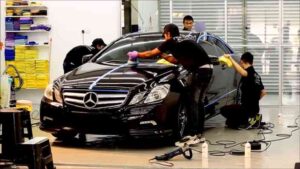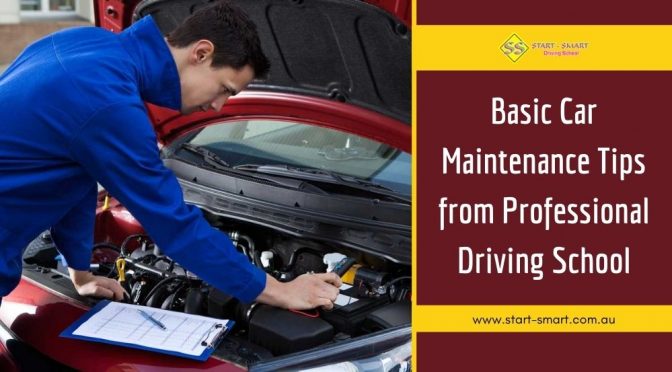Car detailing requires specialized cleaning products and tools, a hyper-focused work ethic, and patience. A few tips from the pros will help you streamline this labor-intensive process.
Detailers should always work indoors or in the shade. This prevents soap and water from drying on the vehicle and splattering grime on freshly rinsed surfaces. For more information Visit Website.

The exterior of a car receives the most attention during detailing. Detailers aim to make it look as good as new, and they also want to protect it from the elements. This is why a thorough yet safe wash, followed by waxing and paint sealant, is the typical order of business.
Unlike a regular car wash, a car detailer carefully avoids scratching or swirling the vehicle’s surface. Instead, a specialized brush, foam pad, or mitt is used to clean the paint and other exterior surfaces gently. In addition, a high-quality automotive shampoo is used to ensure the paintwork and other materials are not damaged. After a safe wash, the vehicle will be rinsed and dried. This step is crucial to minimizing the risk of paint damage and to achieving a high-quality finish.
Paint chips and oxidation will be treated immediately to prevent rust. In addition, doors and door jambs will be cleaned and lubricated to keep them from squeaking. Exterior plastics, rubber, and chrome are also restored during the detailing process, which includes polish and coating with wax.
Tires and wheels are cleaned to remove brake dust and other contaminants, which can lead to corrosion if not removed regularly. Then, a tire dressing and wheel treatment are applied to add shine and protection. This is a key part of the process to maintain and increase the vehicle’s value.
The last step is to apply a protective shield to the paintwork. This can be in the form of a wax, ceramic coating, or clear bras. The choice depends on the vehicle owner’s needs and budget.
Detailing is a detailed version of washing and protecting a car, but it goes much further. It can also include a paint correction and restoration process that restores the car’s appearance to its pre-damage state. Lastly, it can also apply protective coatings to help the vehicle’s paint, vinyl, fabric, and plastic components last longer. In short, it is a complete restoration process that should be done twice yearly to keep a car looking and driving its best.
The inside of your vehicle must be detailed, too, and it goes beyond a quick vacuuming. It includes thoroughly cleaning every nook and cranny so the interior looks like it came out of the showroom. It also helps protect the interior from excessive wear and tear and keeps the car smelling fresh.
The detailing process involves using a variety of tools and products. It may include shampooing the carpets, steam cleaning the seats and the headliner, and scrubbing the dash and other sensitive areas. Some detailers even use a tool similar to an air compressor that has a vibrating cone attachment to concentrate the flow of air to smaller areas. This is particularly helpful on the inside of the doors and around buttons and switches.
Many people are surprised to learn that the car detailing industry is a multi-billion dollar business. The reason is that the work requires a lot of training and skill to get it right. Detailers are trained to use the proper products and tools to ensure a professional result and to avoid damaging the interior of the vehicle. They are also familiar with the nuances of each make and model.
One of the most common reasons a vehicle is brought into a detailing shop is to fix unsightly scratches or other damage. The owner gets the vehicle in to have the work done, and the detailer asks questions to learn more about what caused the damage. This information is used to help the customer prevent future problems.
Another service often included with full detailing is the application of protective coatings. This is particularly helpful for leather or fabric seats. A leather protector keeps the seats from water staining, and a fabric protection product protects against fading or staining.
By taking a proactive approach to care for the interior and exterior of your vehicle, you will extend its life and help it retain value when the time comes to sell it. You will also avoid the costly repairs and replacements that can occur from neglect or a lack of maintenance.
When detailing a car, wheels and tires are often the dirtiest components due to the amount of road grime, brake dust, and other contaminants that they come into contact with. Therefore, they must be cleaned first. This helps to prevent the cleaning solutions from drying out before getting to the rest of the vehicle’s components. When washing the wheels and tires, it’s important to use a high-quality microfiber all-purpose or terry cloth towel dedicated solely for these purposes. This will help to prevent water spots and ensure that all the brake dust is removed.
It’s also important to understand the difference between a wheel and a tire. The wheel is a metal framework that serves as the foundation for the rubber tires. The tire is a separate component that fits around the wheel and directly interacts with the road. It’s crucial to remember this distinction because misusing terms can lead to confusion and mistakes that might affect vehicle performance and safety.
A wheel can be manufactured in various materials, finishes, and sizes. Some common options include aluminum and magnesium alloy, chrome, and bare steel. The wheel’s rim is a circular structure that attaches to the hub and axle and holds the tire. Some rims have spokes that extend from the hub to the edge of the wheel, while others have a center cap or bead seat area where the tire mounts.
The rim size determines the size of the tire that can be mounted on it. Using the right-sized tire can cause problems such as excessive air pressure, poor handling, and uneven tread wear. A tire should be inflated to the manufacturer’s recommended levels for optimal performance.
Detailing wheels and tires regularly can protect them against sidewall cracks and deterioration. It’s also a good idea to inspect them regularly for signs of damage, like cuts and punctures, and to keep them properly inflated. A worn-out or underinflated tire can decrease grip on the road and increase the risk of accidents.
Headlights help you see the road ahead, light up dark areas, and keep other drivers from running into you. Unfortunately, they can also get foggy or discolored over time. This is why car detailing includes cleaning and restoring them to be bright, clear, and in good working order.
Headlight lenses are typically made of polycarbonate plastic, tough and durable enough to handle the road debris and dirt from driving a vehicle daily. However, the sun’s harsh UV rays can slowly break down the outer surface of this plastic, leading to oxidation and fogging. Keeping your headlights in good shape reduces the risk of damage and makes for a safer ride at night.
During the detailing process, professional detailers wash and rinse all surfaces with specialized products. They may use a pressure washer with a QC nozzle to create that stream of water like a wand-like spray. Depending on the detailing service, they may scrub and wax the car’s exterior. Lastly, they will clean the windows with a special glass cleaner to remove any detailing chemicals or vinyl protectant overspray.
After the car has been washed and waxed, the next step is to buff it down with a microfiber cloth to remove any excess product. Once the buffing is complete, you’re ready for the final touches. Many detailers use an app such as Mobile Tech RX to manage their packages and pricing, estimates, branded invoices, bookkeeping (through QuickBooks), payment processing, marketing, and more.
After washing the doors, detailers remove the door seals and rubber molding with a silicone spray to re-lubricate them. Then, they will apply a car wax to protect and shine the rubber molding. A good quality car wax can last up to a year, so it’s worth the investment. Detailers also wipe down the dashboard and door handles with a non-silicone spray to add a nice finish and reduce glare at night. This also helps reduce dust and dirt build-up over time.

